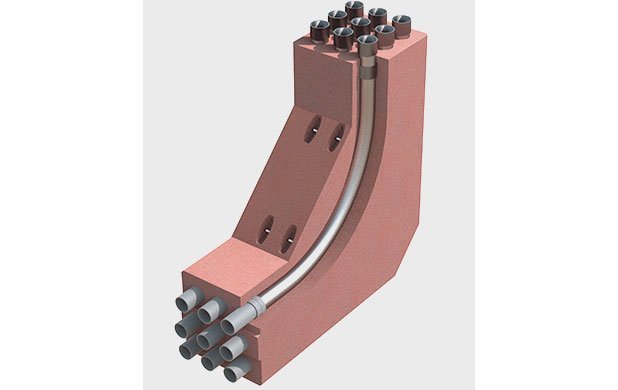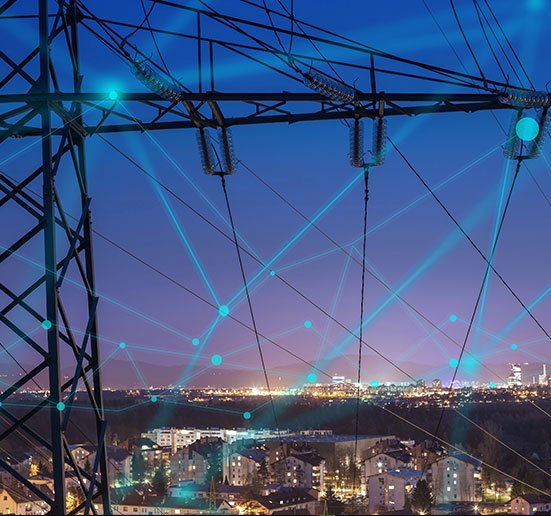What Is A Duct Bank


In simplest terms, a duct bank provides a protected pathway for buried electrical or data cables.
The cables are housed within PVC pipe called conduits, which are then encased in steel reinforced concrete. Duct banks may carry cable a short distance, such as under a road or longer distances, such as carrying electrical power from a power generating source to transmission stations, industrial and public facilities. Extensive duct bank cable system are often required to route electrical cables under and within data centers, industrial and manufacturing facilities, hospitals, rail lines, airports, highways, and more.
Reinforced concrete placed around PVC conduits protects electrical cables from weather, seismic stress, corrosion, temperature extremes, and vandalism to prevent breakage and failure. The conduit arrangement allows for easy cable replacement via the duct bank ends through access at utility structures or at the surface after horizontal runs turn vertical through a vertical bend or “stub-up”.


How to Ensure Proper Duct Bank Installation
Like most construction methods, duct banks require proper installation to ensure performance and long-term durability. Installation of duct banks is a multi-step process that involves construction labor that is knowledgeable and skilled in each step of the installation process:
- Trench and bedding preparation must ensure safe working conditions and provide stability and structural support for the duct bank
- Conduits must be properly aligned, and joints must be cemented
- Steel reinforcement must be precisely placed
- Concrete must meet the project requirements:
- High-quality with heat dissipating properties
- Sufficiently strong


Duct Bank Construction Methods
“Stick Built” or “Cast-in-place” method
The current method for installing duct banks is a cumbersome and lengthy process:

The civil contractor digs and shores up the trench.

The electrical contractor installs the PVC conduits and spacers, ensuring proper spacing at all times.

The civil or electrical contractor cuts, bends and installs steel reinforcement.

The electrical or carpenter crew builds forms to ensure the concrete is placed around the conduits.

Then the concrete must be ordered, scheduled, and dispatched, which may include concrete thermal resistivity testing; the concrete delivery truck arrives at the trench (a pump truck is required if access is not possible); and concrete is poured over and around the conduit, and air pockets removed.
Conduits must be sufficiently anchored to prevent conduit from floating or moving out of position when the concrete is placed. Additionally, as the concrete flows in and around the conduits air pockets must be removed.

Once poured, the concrete must cure at least overnight or until the concrete gains sufficient strength so the forms can be removed and the trench backfilled with soil. Along with time and inefficiencies, there are a lot of things that can go wrong or cause delays with this traditional process: If any conduit joints are open, concrete will flow into the conduit and hardened concrete will block conduits, preventing wire cabling from being installed/pulled through.
Rainy conditions or freezing temperatures can delay concrete placement. Significant rain that occurs prior to concrete placement can result in trench flooding, with debris, sand, and dirt filling in between conduits requiring conduits to be removed, cleaned and replaced.

Pre-fabrication
Prefabrication of conduit assemblies offer an improvement over traditional stick-built, cast in place duct bank construction methods, but still presents challenges. This process starts with digging and preparing the trench. Electrical contractors pre-assemble conduit skids, racks, and stub-ups in a fabrication shop and ship them to the project site, where the conduit subassemblies are installed along with steel reinforcement. After the assemblies are placed, the steps are the same for building the concrete forms, ordering and scheduling the concrete, pouring, removing the forms, and backfilling.
Prefabrication does reduce onsite duct bank construction time—with prefabrication, the PVC conduits are spaced properly and ready to go when the site is ready. But the required care, and potential delays, of the concrete pour remain the same for duct bank installation. Labor costs may be the same or more to incorporate the spacers and conduit into modular sub- assemblies that can be handled as larger units. Equipment to handle the modular components must be able to access the trench and place the components into position. Connection of individual conduit joints may be challenging as the conduit is not easily manipulated within the module.


Pre-Cast Duct Banks A Modern Method for Installing Duct Banks
Pre-cast duct banks eliminate many of the hassles of traditional and pre-fabricated duct bank construction methods described above. Pre-cast duct bank sections are produced in a variety of conduit sizes and configurations.

Straight sections are provided in lengths that are easily handled by construction equipment, fork lifts and backhoes commonly on site.

Vertical bends also known as stub ups, can also be provided as pre-cast duct bank sections furnished in a variety of conduit sizes and configurations.
All pre-cast duct bank sections are built under factory-controlled conditions and are delivered to the jobsite ready to be installed.

Pre-cast duct banks allow for new construction techniques that deliver the most viable, reliable, safer, and cost-effective means of installing duct banks. The resulting efficiencies, reduce the cost of labor, reduce the impact of weather, and improve worker safety. The time to construct duct banks can be significantly reduced and with trenchs backfilled immediately after installation allow for quick site access. With pre-cast duct banks, it is not uncommon to install a 500ft long run of 25 conduits (12,500ft of conduit) in less than eight hours.
What Are the Benefits of Pre-Cast Duct Banks?
The time savings and performance assurances brought by pre-cast duct banks are felt across nearly the entire project team, benefiting the design engineer, installation contractor and the project owner.

Project Owner
For project owners, pre-cast duct banks help reduce overall construction costs while significantly reducing on-site construction time. Plus, the quality assurances provided by factory assembly and robust testing provide peace of mind for long-term performance.
- Faster installation reduces on-site labor needs and costs
- The impact of weather-related delays is reduced so projects can get started when needed, and finish sooner
- Consistent concrete thermal properties improves heat dissipation and performance of underground cables
Project Engineers
The use of standard pre-cast duct bank configurations offer designers and installers a “plug and play” solution.
- Standard configurations simplify the design process and enhance flexibility
- Horizontal and vertical stacking of pre-cast duct bank sections allow for larger and more complicated geometries while maintaining the benefits of standardization
- Heavy loading conditions are accommodated without the need to design for supplemental steel reinforcement
Pre-cast duct bank suppliers offer engineering support and assistance with:
- Duct bank configuration and layout review
- Thermal resistivity measurement and test procedures
- Digital design files including pre-cast duct bank components and layout drawings


Project Contractors
As skilled labor shortages continue to burden the construction industry, installation strategies that reduce staffing loads and streamline processes are critical to keep projects on track and quality under control. Pre-cast duct bank provides improvement in both areas.
- Fewer workers and less time in the trench reduces opportunity for injury
- Reduces or eliminates the need for specialty craft labor for cast-in-place work, as well as associated form work, steel placement, redi-mix delivery, and curing time
- Pre-cast duct bank sections arrive ready for placement and fully cured yielding a faster installation and quicker backfill to allow above-ground construction to commence sooner, even the same day
- Eliminates hazardous exposure to solvents and epoxies normally required for connecting PVC conduit
- Can be installed in rainy and cold conditions, reducing weather related downtime
Public
- Less roadway downtime and disruption
- Electrical and data lines in service faster





